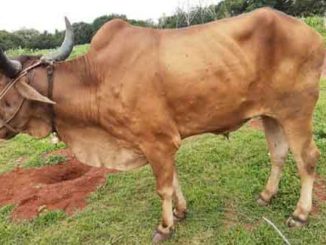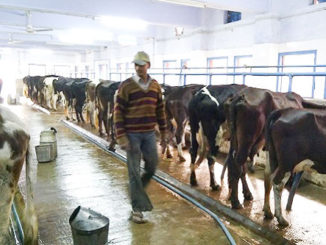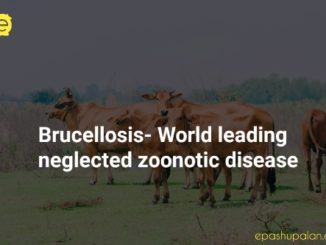Introduction
Infectious diseases are caused by biological agents like viruses, bacteria and fungi, which can be transmitted from animal to animal. These diseases cause economic losses to farmers by mainly decreasing the milk production in dairy animals. It can be controlled or prevented by timely and proper vaccination of farm animals.
Vaccination is the administration of a vaccine to boost the immune system for protection from a disease. A vaccine (or immunization) is a way to build animal’s natural immunity to a disease before the animals gets infected. Vaccine contains a small amount of the disease germ (virus or bacteria) or parts of the germ in a weakened or killed state, or proteins or toxins from the organism. In stimulating the body’s adaptive immunity, they help to prevent sickness from an infectious disease. Following are some important viral and bacterial diseases along with their preventive measures in farm animals which causes economic loss to farmers and required vaccination at regular time interval.
Foot-and-mouth disease (FMD)
Foot and mouth disease is a severe, highly infectious and contagious viral disease of livestock that has a significant economic impact. The disease affects cattle, swine, sheep, goats and other cloven-hoofed ruminants. The virus causes high fever lasting two to six days, followed by blisters inside the mouth and on the feet that may rupture and cause lameness.
Transmission:
- Infected animals newly introduced into a herd (carrying virus in their saliva, milk, semen, etc)
- Contaminated pens/buildings or contaminated animal transport vehicles
- Contaminated materials such as hay, feed, water, milk
- Contaminated clothing, footwear, or equipment etc
Symptoms:
- High fever
- Vesicles and ulcers on tongue, dental pad, oral mucosa and interdigital space
- Profuse salivation, lameness
Prevention:
- Vaccination should be given at 4 months of age and it should be repeated at every 6 months
- Isolation of all affected animals after detection
- Burning of contaminated fodder and bedding material
- Animal shed must be cleaned with caustic soda or formalin
- Calves should not be allowed to suckle affected mothers
Treatment: There is no specific treatment, generally recovers within 8-10 days.
Symptomatic treatments:
- Parenteral injection of broad spectrum antibiotics to prevent secondary bacterial infection and analgesic
- Mouth wash with 1% KMNO4 or 2 % Sodium carbonate solution
- Apply boroglycerine on mouth lesions
- Foot wash with 2 % copper sulphate or 2 – 4 % sodium carbonate solution
Post FMD complication:
- Abortion
- Mastitis
- Infertility
- Panting
Haemorrhagic Septicemia (HS)
It is one of the most economically important infectious disease. The disease occurs mainly in buffaloes and cattle, but also has been reported in goats, generally occurs during rainy season, extreme environmental conditions, malnutrition and long distance transportation. A wide variety of clinical signs have been described for HS in buffaloes and cattle. The incubation periods (the time between exposure and observable disease) for buffalo calves 4–10 months of age varies according to the route of infection. The incubation period is 12–14 hours, approximately 30 hours and 46–80 hours for subcutaneous infection, oral infection and natural exposure, respectively.
Transmission:
- By direct contact with infected animals and infected clothes, utensils etc.
- Cattle and buffalo become infected when they ingest or inhale the causative organism, which probably originates in the nasopharynx of infected animals. In endemic areas, up to 5% of cattle and water buffalo may normally be carriers
- The worst epidemics occur during the rainy season, in animals in poor physical condition
- Stresses such as a poor food supply are thought to increase susceptibility to infection, and close herding and wet conditions seem to contribute to the spread of the disease
- multocida can survive for hours and possibly days in damp soil or water; viable organisms are not found in the soil or pastures after 2–3 weeks
Symptoms:
- High fever (106 – 107°F)
- Swelling of the head, neck, and brisket occurs in nearly all cases
- Swelling of throat region (sub mendibular edema)
- Difficult breathing
- Lacrimation
- Recumbancy and death within 10-72 hours.
Prevention:
- Vaccination every year before monsoon
- Isolation of all affected animals after detection
- Burning or burial of dead animals
- Proper disposal of contaminated feed and water
- Disinfection of cattle shed
- Avoid long distance transportation
- Avoid crowding, especially during wet conditions, will also reduce the incidence of disease
Treatment:
- Treatment is effective if given in early stage
- Parentral injection of antibiotics, antipyretics and antihistamininc
- Fluid therapy- Infusion of 5 % DNS I/V as supportive therapy
Black quarter or Blackleg (BQ)
It is an infectious bacterial disease most commonly caused by bacteria called Clostridium chauvoei. It is seen in livestock all over the world, usually affecting cattle, sheep, and goats. It has been seen occasionally in found bison and deer. The disease occurs suddenly which makes difficult in successful treatment and the efficacy of the commonly used vaccine is also hampered.
This disease mostly affects when the cattle are between the ages of six months and two years, although it can occur when they are as young as two months. Mostly, cattle that have good feed intake and are well-conditioned tend to be the most susceptible to blackleg.
Transmission: The spores of the organism can remain in the soil for years in an inactive state, and return to their infectious form when consumed by grazing livestock. Contaminated pasture is a major source of these organisms, which are also found naturally in the intestines of animals. Cases can occur over many years in areas where soil or manure is contaminated with the bacteria, and it is exceedingly difficult to remove the spores from the environment.
Symptoms:
- High fever
- Lameness in affected legs
- Crepitating, hot and painful swelling over the affected legs
Prevention:
- Vaccination should be given at 4 months of age and must be repeated every year
- Isolation of all affected animals after detection
- Deep burial or burning of dead animals
- Avoid grazing in affected area
Treatment:
- Parenteral injection of penicillin @ 10000 units/kg body weight for 5-6 days intramuscularly.
- Injection of BQ antiserum if available
- Parenteral injection of antipyretics and antihistaminic
- Fluid therapy – Infusion of 5% DNS I/V as supportive therapy
Anthrax
It is a serious infectious disease of animals and humans, caused by gram-positive, rod-shaped bacteria known as Bacillus anthracis. Anthrax spore can be found naturally in soil and commonly affects domestic and wild animals around the world. Anthrax causes acute mortality in ruminants and is a zoonosis. The bacteria produce extremely potent toxins which are responsible for the ill effects, causing a high mortality rate. The bacteria produce spores on contact with air.
Transmission: Infection usually spread through the ingestion of contaminated soil, fodder or compound feed. Anthrax spores in the soil are very resistant and can cause disease when ingested even years after an outbreak. The spores are brought to the surface by wet weather, or by deep tilling, and when ingested or inhaled by ruminants the disease reappears. Where an outbreak occurs, carcasses must be disposed of properly, the carcass should not be open (exposure to oxygen will allow the bacteria to form spores) and premises should be quarantined until all susceptible animals are vaccinated.
Vaccination in endemic areas is very important. Although vaccination will prevent outbreaks veterinary services sometimes fail to vaccinate when the disease has not appeared for several years. But because the spores survive for such lengthy periods, the risk is always present.
Symptoms:
- Sudden rise in body temperature (104-108 ˚F)
- Difficult breathing
- Blood in milk
- Abortions in female
- Bleeding from natural openings like anus, nostrils, vulva, sudden death
- Sudden death (often within 2 or 3 hours of being apparently normal) is by far the most common sign
- Very occasionally some animals may show trembling, a high temperature, difficulty breathing, collapse and convulsions before death. This usually occurs over a period of 24 hours
- After death blood may not clot, resulting in a small amount of bloody discharge from the nose, mouth and other openings
Diagnosis:
- On the basis of clinical signs.
- Rod-shaped bacteria surrounded by a capsule are visible in blood smears made from surface blood vessels.
- Post-mortem examinations should not be undertaken on suspected anthrax cases (including any cow that has died suddenly for no apparent reason) until a blood smear has proved negative);
- If a carcass is opened accidentally, the spleen is usually swollen and there is blood stained fluid in all body cavities.
Prevention:
- Vaccination with Anthrax spore vaccine @ 1ml S/C every year before monsoon season
- Identification and isolation of affected animals
- Deep burial of dead animals
- Never conduct post mortem of dead animal suspected to anthrax
- Disinfection of cattle shed by using 10 % caustic soda or 5% phenyl
Treatment:
- Treatment is effective in initial stage of the disease
- Injection penicillin @ 10000 units/kg body weight intramuscular for 5-6 days
- Anti-Anthrax serum @ 100-200 ml I/V if available
- Supportive injection of antipyretic, antihistaminic and fluid therapy
Due to the rapidity of the disease treatment is seldom possible, although high doses of penicillin have been effective in the later stages of some outbreaks.
Brucellosis
Brucellosis infection is caused by Brucella abortus, in worldwide which causes of bovine abortion that may infect wild species also. Brucellosis is an important zoonosis and all precautions must be taken against acquiring infection. Veterinarians are especially at risk when removing retained placenta and examining aborted cows and the products of abortion. The condition in humans was commonly acquired by drinking unpasteurized contaminated milk.
Transmission: As Brucellosis is an important zoonotic disease, the bacteria are transmitted from animals to humans by ingestion through infected food products, direct contact with an infected animal, or inhalation of aerosols. The disease has been known by various names, including Mediterranean fever, Malta fever, gastric remittent fever, and undulant fever. Humans are accidental hosts, but brucellosis continues to be a major public health concern worldwide and is the most common zoonotic infection. Brucella organisms, which are small aerobic intracellular coccobacilli, localize in the reproductive organs of host animals, causing abortions and sterility. They are shed in large numbers in the animal’s urine, milk, placental fluid, and other fluids.
Clinical Symptoms: Abortion during the last trimester with retention of placental, followed by poor lactation.
Diagnosis:
- Based on clinical signs such as abortions, but confirmation is made through serological tests
- Prescribed laboratory tests to isolate and identify the bacteria
Prevention and control: Surveillance using serological tests, as well as tests like milk ring test, can be used for screening and play an important role in campaigns to eliminate the disease. Individual animal testing for disease control purposes is also being practiced. In endemic areas, vaccination is often used to reduce the incidence of infection. Several vaccines are available that use modified live viruses.
Human brucellosis is best prevented by controlling the infection in animals. Pasteurisation of milk from infected animals is an important way to reduce infection in humans.
Following table is the vaccination schedule for cattle and buffalo to prevent important infectious diseases.
Vaccination Schedule
|
SN |
Disease | Animal | Vaccine | Dose | Immunity |
Time of vaccination |
|
1. |
Foot & Mouth Diseases (FMD) | All cloven footed animals | Polyvalent FMD vaccine | 3 ml S/C | 1 Year | February & December |
|
2. |
Hemorrhagic
Septicemia (HS) |
Cattle, Buffalo | HS Vaccine | 5 ml S/C | 6 month & 1 Year | May-June |
|
3. |
Black Quarter
(BQ) |
Cattle, Buffalo | BQ Vaccine | 5 ml S/C | 6 month & 1
Year |
May-June |
|
4. |
Anthrax | All species of animals | Anthrax Spore Vaccine | 1 ml S/C | 1 Year | May-June |
|
5 |
Brucellosis | Female calves | Brucella S-19 vaccine | 2 ml s/c | lifetime | 4-8 months of age |
Note – Before any vaccination deworming should be done for better results.
Conclusion
The above mentioned infectious diseases are serious problem in animals, so special care should be taken to milch animals and should be vaccinated periodically with the opinion of veterinarians. Vaccination in the last trimester in pregnant animals prevents the calves from infection until 4 months of age, so vaccination of pregnant animals must be done. So it is recommended that to prevent economic loss from the diseases, the farmers should follow the vaccination schedule at regular time interval.
|
The content of the articles are accurate and true to the best of the author’s knowledge. It is not meant to substitute for diagnosis, prognosis, treatment, prescription, or formal and individualized advice from a veterinary medical professional. Animals exhibiting signs and symptoms of distress should be seen by a veterinarian immediately. |







Very detailed analysis